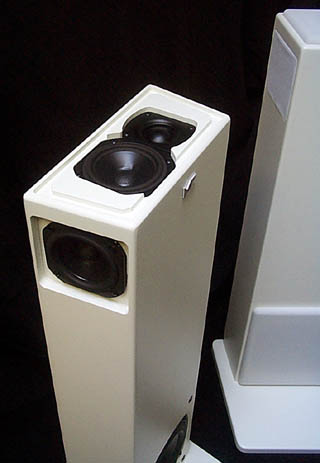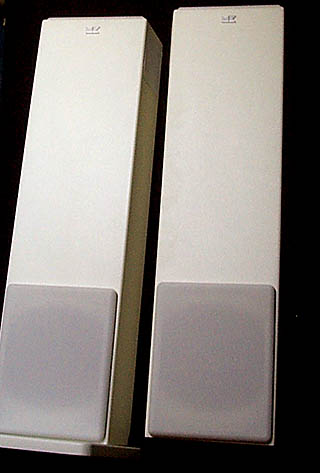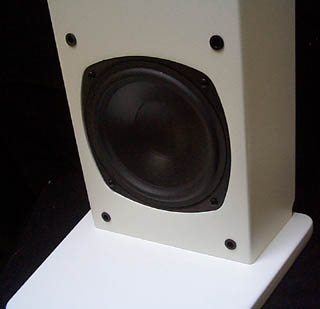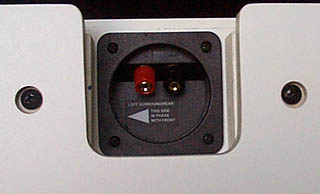Despite Miller and Kreisel's (M&K) reputation as
primarily a subwoofer/satellite company, if I were to sum up what M&K truly
does, by virtue of the products and services they offer, I would call them
an Audio Monitoring Solutions Provider.
Sure, they sell subwoofers that
kick butt without breaking a sweat, along with satellite speakers that will let
you hear the texture of peanut shells blowing out of an elephants trumpeting
snout. What really differentiates M&K, in my mind, is their emphasis on
getting real results in the final analysis, for the end user, not just on
the test bench, or in the dedicated listening room that only the luckiest of
us enjoy.
The Tripole
M&K was the first company I noticed to offer a
variation between the dipole and the direct radiating speaker for surround
use. They called this the Tripole loudspeaker which addressed the real world issues of
loudspeakers in the surround field. Dipolar speakers, though superb for
unconditionally providing a very diffuse surround field, often, though not
always (Brian Florian would kick me for stating that as an absolute)
lack the immediacy provided by more directional speakers when localization
is needed.
Direct radiating loudspeakers, on the other hand, unless
craftily located with plenty of space between the listening area and the
loudspeaker, can often be far too obvious. If not done cleverly, because of
the wide angular separation between themselves and other speakers, they can
call attention to themselves, distract focus from on-screen activities, or
simply detract from the sense of immersion. M&K's Tripole solution
addressed this, providing better results in more environments by combining
the direct radiation and dipolar radiation patterns into a single
loudspeaker. Eventually, other manufacturers followed suit one way or
another, some with success and others with less.
Bass Management
Long before receivers or preamplifiers came standard
with ‘Bass Management,' M&K was promoting the benefits of truly active
bi-amplification by the use of active subwoofers combined with satellites
fed through high-pass filters prior to amplification. As such tools were
not readily available in the consumer market, they provided in-line
high-pass filters so that users could realize the increased dynamic range
and lower distortion afforded by routing low frequency content exclusively
to subwoofers, long before Dolby Digital and THX mandated bass management in
surround sound processors.
When it became apparent that the bass management in
receivers, DVD Audio, and SACD players was either lacking or completely
unavailable when using the 5.1 analog feeds for these high-resolution audio
formats, guess who had a working, high-performance answer? M&K's BMC-Mini,
and you're all good again. Want to step it up a notch for a fully balanced
solution? Grab M&K's LFE-4 and you're there.

The CS-29s
This
dribble brings me to the topic of the present review, the CS-29 ‘Column Surround'
loudspeakers. M&K created
a line of surround speakers to address one of the most common problems in
surround field reproduction: rear and side speaker placement.
In our ideal room, we're working in circumstances where
the listening position provides more than a few feet, often eight, ten, or
more between the listeners' ears and each surround loudspeaker. In
addition, we like to have the surround loudspeakers placed on the high side,
say 6 feet up, or a bit more, to add to the ambient, enveloping
presentation. Put the speakers too close or too low, and the surround field
reproduction can distract from the front soundstage, a detriment to the
involvement in cinematic material and musical material alike.
Most of us who are dedicated hobbyists and motivated to
cruise website and paper ‘zines alike might assume that any end user who's
got a clue would make the right choice in doing things. That is, put the home theater rig in a room that allows higher and
distant placement of the surround speakers. After all, if we're gonna do
it, we're gonna do it right, right?
Wrong. With the exception of those lucky enough to
wrangle one of these ideal (and often by necessity, dedicated) rooms, the
subwoofer often goes where you have space to put it, the front speakers
likely take the best positions the furniture and TV will allow, and the
surround channels hopefully land somewhere in the vicinity that isn't in the
front! Oh, the horror! What a world, what a world, I'm melting .
. .
Even if one has the incentive to do it right, there are
situations that may daunt the multi-channel audiophile with even the
clearest priorities. If there are no side or rear walls (for instance the
room opens up to other rooms), the listening couch is backed up against a
room boundary, or other circumstances prohibit placement of the surround
speakers either high and/or farther away than right next to the listener,
you've got somewhat of a problem.
And
here we are, at the topic of this book report. The CS-29, and for that
matter all of the Column Surround models are derivations of the original Tripole surround designs that M&K pioneered a few years ago. The main
direct/dipolar assembly in the CS-29 looks very much like the Xenon
Surround-25 with the polymer-based midrange/full-range elements and that
compact, soft-dome tweeter with its neodymium magnet. For any interested in
that story,
http://www.hometheaterhifi.com/volume_9_1/mk-xenon-k-sub-2-2002.html.
 However,
unlike the Xenon Tripole surround speakers, the direct radiating components
of the CS-29 are mounted to fire upwards, instead of directly at the
listener, putting the direct component of the sound primarily up and around
the listener, while the dipolar elements fire forward and rearward propel
sound almost exclusively to the side and away from the listener. It's
slightly more directional than a dipolar array, and will help achieve height
in the surround field from a floor-standing location, by steering a
proportion of the reflected sound to get to the listener from above.
However,
unlike the Xenon Tripole surround speakers, the direct radiating components
of the CS-29 are mounted to fire upwards, instead of directly at the
listener, putting the direct component of the sound primarily up and around
the listener, while the dipolar elements fire forward and rearward propel
sound almost exclusively to the side and away from the listener. It's
slightly more directional than a dipolar array, and will help achieve height
in the surround field from a floor-standing location, by steering a
proportion of the reflected sound to get to the listener from above.
Sending sound directly upwards to achieve height in the surround field isn't
a new idea. Dolby advocated it when giving advice on how to get the most
out of Dolby Surround in situations where mounting speakers on the wall
wasn't an option. They suggested placing the speakers back down on the
floor. The only problem was that most of the sound was absorbed by the
couch, and what wasn't absorbed was now bass heavy, and most speakers didn't have
the even power response necessary to sound decent when most of the sound was
reflected. M&K incorporated that idea into a Tripole radiation pattern to
address both the height and proximity issues, and then raised it slightly to
miss the sides of the couch by placing it on the top of the column, and did
the rest of the work necessary to make it a good speaker for that position.
As floor placement often requires that the surround
speakers sit on the floor, M&K made use of the additional enclosure volume
by rounding out the driver complement with a 6 ½” woofer, placed at the
base, providing more low frequency extension and punch than the smallish
Xenon line, opening its use to a far wider range of subwoofer crossover
frequencies, perhaps as low as 55 Hz - 60 Hz. That much extension won't be
necessary for most applications, but the flexibility is nice.
 Should
our heroes be able to put the Column Surround against a wall, the design of
the units allows detachment of the base. We can then mount the speaker
directly against the wall without the ‘feet sticking out', complete with
wiring channels in the speaker for ease of installation.
Should
our heroes be able to put the Column Surround against a wall, the design of
the units allows detachment of the base. We can then mount the speaker
directly against the wall without the ‘feet sticking out', complete with
wiring channels in the speaker for ease of installation.
Incidentally, the speakers are left and right specific,
labeled so on the loudspeaker terminals, so that the driver of the dipolar
element that operates in-phase with the front speakers faces the front of
the room. If you're hiring custom installers, make sure they can read.
That pretty much wraps up the background check.
The Performance
After taking the glamour shots, I plopped the pair of
CS-29s where they'd best exhibit their potential design advantages, right next to my couch. Too close and too low for most surround speakers,
and almost completely out of the way, if any of my friends suggested this
placement with any other speakers they'd receive a good eye-rolling.
 Riding
the tide with a bunch of movies, the CS-29s did exactly what they were
supposed to do. The THX trailers with the cows, sound effects from the
slowly growing library of children's movies, be it "Finding Nemo", "Monsters
Inc.", "Jimmy Neutron", or "Lord of the Rings", superbly wrapped me up in an
enveloping surround field of water, alarm buzzers, space ships and unnatural
disasters, but with enough specificity to imply direction. I heard things
come from somewhere ‘over there' without being able to distinguish the
loudspeaker location, exactly the kind of thing we look for in movies. Is
that too short for a description of what it does with theatrical content?
Well, you can go and find your favorite glowing verbiage in some other
review, and paste it in right here with my blessings. It worked darn well,
no complaints.
Riding
the tide with a bunch of movies, the CS-29s did exactly what they were
supposed to do. The THX trailers with the cows, sound effects from the
slowly growing library of children's movies, be it "Finding Nemo", "Monsters
Inc.", "Jimmy Neutron", or "Lord of the Rings", superbly wrapped me up in an
enveloping surround field of water, alarm buzzers, space ships and unnatural
disasters, but with enough specificity to imply direction. I heard things
come from somewhere ‘over there' without being able to distinguish the
loudspeaker location, exactly the kind of thing we look for in movies. Is
that too short for a description of what it does with theatrical content?
Well, you can go and find your favorite glowing verbiage in some other
review, and paste it in right here with my blessings. It worked darn well,
no complaints.
Now let's talk fidelity. With movies, there's not a
lot of really demanding content in the rear channels. It may occasionally
be loud and dynamic, but it's not something that usually demands a
high-fidelity loudspeaker. Brian Florian is now growing livid, about to
point out that cinematic content places so much of the music in the ambient
surround field. Well, he's right, but personally speaking, when I watch
movies, I don't usually notice if the background music sounds accurate. For
me, so long as the speakers don't grossly distort, but match fairly well
tonally, and have a somewhat balanced power response in the room, the
specifics of a surround speaker aren't typically that critical for cinematic
applications. Now, with DVD-Audio (DVD-A) content, it's another story.
It's truly a shame that DVD-A is taking as long as
it is to latch onto the mainstream music industry. It's getting there, but
many of the recording engineers need some multi-channel practice, fast.
Most of the mixes out there, despite the performance potential of the DVD-A format, suck eggs. The Bare Naked Ladies tracks from the Warner
Brothers DVD-A sampler just about killed me with despair. Whoever did
those really needs some M&K monitors };>)
On the bright side, there are some pretty good DVD-A releases, and even a few that are absolutely superb.
The "Big Phat Band" DVD-A disc consistently wows me
and yeah, two of my friends, when it's given the playback benefit of M&K's
fully active system and the complete bass management and time-alignment
capabilities of Anthem's AVM-20 processor. What I really wanted to know about the
CS-29s is whether they could keep up with the S-150Ps and MX-5000 mkII
when given such demanding, dynamic, and detailed material.
No problem.
On Sing Sang Sung, the directionality was enough
to provide the presence of a live event, but not so much to be a pain, even
at 3 feet, which I thought remarkable. While I still maintain that I prefer
performance of the matching, fully active SS-250Ps, which edged out a
little better detail, the CS-29s exhibited no obvious limitations or flaws,
and translated every bit of excitement in the surround field. During
Mueva Los Huesos the use of the surround channels is quite aggressive,
putting the listener in the middle of the band, particularly with those
shaker thingies, but the presentation was neither annoying, lacking, nor a
mere novelty.
While listening to There's the Rub, I thought to
myself that the blend between the surround field and the front channels was
terrific, noting that while the CS-29s didn't have the presence of the more
‘conventional' Tripole surround speakers mounted up high and away, they did
the job quite well, offering a subtle envelopment that never detracted from
the experience. A couple times I got up out of my seat to see if they were
actually playing. The most obvious way to hear what the CS-29s contributed
was to turn the amplifier for the surround channels off, after which the
whole surround field of course vanished, and the depth of the front
soundstage collapsed as well. Whether this is an indication of how well the
CS-29s did their job at surround field reproduction, or just illustrates
the importance of multi-channel music reproduction, I don't know. I'll
defer to whoever's willing to take responsibility.
I almost forgot, these
things can crank too.
Another of my favorite DVD-A discs is Steely Dan's
"Two Against Nature", which in general makes copious, though tasteful
use of the surround channels. While listening to this album, I opined the
CS-29's place on the diffuse/direct surround channel continuum, closer to a
dipole than a direct radiator, but still having enough directionality to
offer somewhat specific placement. If one were to commit to a single place
on this continuum, hoping to provide a good experience in the widest range
of environments, this would be a safe place to nestle in. On Gaslighting
Abbie, the background singers resided very distinctly in the surround
field, but without becoming annoying or unsettling. During Cousin
Dupree, the cymbals play from the rear, a mix decision that has the
potential to be quite irritating if the surround reproduction is too
localized. Using direct radiation in close proximity during this track,
even with elevated loudspeaker positions, drives me nuts. With the CS-29s,
though, the cymbals sat elevated in the surround field above my head, even
if the CS-29s themselves were below. Nifty trick. The background vocals
remained in the background as well, as opposed to behind the ears. Very
nice.
Conclusions
I suppose I should sum up, lest I bore anybody any more
than the irrevocable damage I've already inflicted fluffing my ego with the
notion that somebody cares what I think. Well, it was fun. The
CS-29, and I expect all of the similar column surround loudspeakers, provide
a viable, high-performance solution to environments that pose significant
surround speaker placement dilemmas. Placed next to a couch, even almost
right up on the back of your head, they can throw a surround sound field
with the best of them, and keep up with extremely high fidelity playback to
boot.
Even for ideal rooms with many good placement options, if you'd like
dispersion characteristics similar to dipolar speaker, but not quite that
extreme, a Column Surround experience might just be your ticket. For
circumstances where surround placement is difficult, something like the
CS-29 might be the only logical choice.
If you're already an M&K
fan, you probably won't need much urging to give these some consideration.
And if you're not yet a member, here's one more reason to join the M&K
Evangelical Church. I hear angels. Big Phat Thumbs Up.
- Colin Miller -
Equipment used during
this review:
Anthem AVM-20 Surround Processor/Preamplifier
M&K S-150P Active Monitors
M&K SS-250P Active Surround Speakers
M&K MX-5000mkII Subwoofer
Bryston 4B-SST Power Amplifier
Dynaco ST-400 mkII Power Amplifier
Technics DVD-A10 DVD-V/DVD-A player